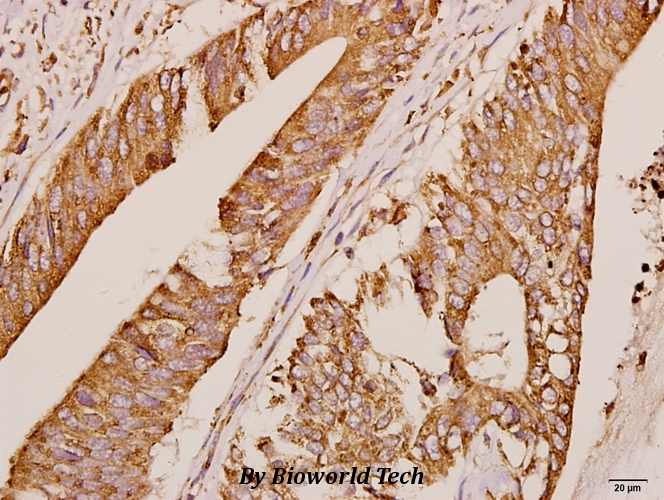Product Name :
GRK1 (A17) polyclonal antibody Background :
Heterotrimeric G protein-mediated signal transduction is a dynamically regulated process with the intensity of signal decreasing over time despite the continued presence of the agonist. This phenomenon, referred to as agonistmediated desensitization, involves phosphorylation of the receptor by two classes of enzymes. The first class is comprised of the second messengerregulated kinases, such as c-AMP dependent protein kinase A and protein kinase C. The second class includes the G protein-coupled receptor kinases (GRKs). At least seven members of the GRK family have been identified. These include rhodopsin kinase (GRK 1α and β); two forms of β-adrenergic receptor kinase: GRK 2 (βARK, βARK1) and GRK 3 (βARK2); IT-11 (GRK 4); GRK 5; GRK 6; and GRK 7. Phosphorylation of receptors by GRKs appears to be strictly dependent on the receptor being in its agonist-activated state. Product :
Rabbit IgG, 1mg/ml in PBS with 0.02% sodium azide, 50% glycerol, pH7.2 Storage&Stability :
Store at 4°C short term. Aliquot and store at -20°C long term. Avoid freeze-thaw cycles. Specificity :
GRK1 (A17) polyclonal antibody detects endogenous levels of GRK1 protein. Immunogen :
Synthetic peptide, corresponding to the N-terminal of Human GRK1. Conjugate :
Unconjugated Modification :
Unmodification
GRK1 (A17) polyclonal antibody Background :
Heterotrimeric G protein-mediated signal transduction is a dynamically regulated process with the intensity of signal decreasing over time despite the continued presence of the agonist. This phenomenon, referred to as agonistmediated desensitization, involves phosphorylation of the receptor by two classes of enzymes. The first class is comprised of the second messengerregulated kinases, such as c-AMP dependent protein kinase A and protein kinase C. The second class includes the G protein-coupled receptor kinases (GRKs). At least seven members of the GRK family have been identified. These include rhodopsin kinase (GRK 1α and β); two forms of β-adrenergic receptor kinase: GRK 2 (βARK, βARK1) and GRK 3 (βARK2); IT-11 (GRK 4); GRK 5; GRK 6; and GRK 7. Phosphorylation of receptors by GRKs appears to be strictly dependent on the receptor being in its agonist-activated state. Product :
Rabbit IgG, 1mg/ml in PBS with 0.02% sodium azide, 50% glycerol, pH7.2 Storage&Stability :
Store at 4°C short term. Aliquot and store at -20°C long term. Avoid freeze-thaw cycles. Specificity :
GRK1 (A17) polyclonal antibody detects endogenous levels of GRK1 protein. Immunogen :
Synthetic peptide, corresponding to the N-terminal of Human GRK1. Conjugate :
Unconjugated Modification :
Unmodification
-

-
 Immunohistochemistry (IHC) analyzes of GRK1 (A17) pAb in paraffin-embedded human colorectal carcinoma tissue at 1:50.
Immunohistochemistry (IHC) analyzes of GRK1 (A17) pAb in paraffin-embedded human colorectal carcinoma tissue at 1:50.
Bioworld Biotech only provide peptides for our antibodies and do not provide additional peptide customization services.
Price/Size :
USD 368/1mg/vial
Tips:
For phospho antibody, we provide phospho peptide(0.5mg) and non-phospho peptide(0.5mg).Describe :
Blocking peptides are peptides that bind specifically to the target antibody and block antibody binding. These peptide usually contains the epitope recognized by the antibody. Antibodies bound to the blocking peptide no longer bind to the epitope on the target protein. This mechanism is useful when non-specific binding is an issue, for example, in Western blotting (WB) and Immunohistochemistry (IHC). By comparing the staining from the blocked antibody versus the antibody alone, one can see which staining is specific; Specific binding will be absent from the western blot or IHC performed with the neutralized antibody.Formula:
Synthetic peptide was lyophilized with 100% acetonitrile and is supplied as a powder. Reconstitute with 0.1 ml DI water for a final concentration of 10 mg/ml.The purity is >90%,tested by HPLC and MS.
Storage:
The freeze-dried powder is more stable. For short time at 2-8°C. For long term storage store at -20°C.
Note :
This product is for research use only (RUO only). Not for use in diagnostic or therapeutic procedures.
 GRK1 (A17) polyclonal antibody
GRK1 (A17) polyclonal antibody  Datasheet
Datasheet COA
COA MSDS
MSDS SHIP
SHIP